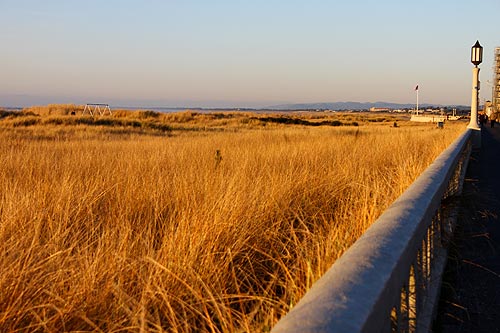 |
Crabbing and Wildlife Report from Oregon Coast Officials
Published 03/01/2012

(Oregon Coast) – Hummingbirds, newts, nesting birds and other critters are in varying degrees of abundance on the Oregon coast for March and the spring break weeks. Oregon Department of Fish and Wildlife released its latest report on what you can and can't find in the region (above: Seaside and Clatsop beaches, where clamming is great right now).
For those wanting to indulge in crabbing, this has slowed because of the rain and the decrease in salinity level in the bays. Crabbing by the general public for recreational purposes in the ocean is open along the entire Oregon coast until October 16, and snagging Dungeness crab in Oregon bays and estuaries is open year-round.
 ODFW reports hummingbirds are now showing up aplenty along the coast. Rufous hummingbirds are one of the first to start migrating, and they nest farther north than other like birds (at right:: starfish finds in Arch Cape, near Cannon Beach).
ODFW reports hummingbirds are now showing up aplenty along the coast. Rufous hummingbirds are one of the first to start migrating, and they nest farther north than other like birds (at right:: starfish finds in Arch Cape, near Cannon Beach).
“Most rufous humming birds winter in wooded areas in the Mexico state of Guerrero,” ODFW said. “They travel more than 2,000 miles – a prodigious journey for a bird weighing only three or four grams. They often stay in one spot for considerable time and often aggressively take over and defend feeding locations.”
Catching sight of some amphibians along the Oregon coast should be good as well in March. ODFW said to look out for rough-skinned newts, Pacific giant salamanders, red-legged frogs and other Oregon coast amphibians as they cross fields, lawns, roads and paths to find appropriate ponds and other still bodies of water to lay their eggs.
“Look just below the surface of the water at wetlands for clusters of eggs,” ODFW said. “A close inspection will reveal the embryo developing and often moving in the transparent egg.”
ODFW warned that many kinds of newts produce toxins to deter predators – and those in Oregon can be particularly deadly. It takes an incredibly small amount of toxin from the skin of an average adult rough-skinned newt to kill a human – a mere 1/30th of the toxin produced by the creature's skin. Most of the dangers lie in eating such a newt, however. Although ODFW said there have been instances of some people with sizable skin irritations after handling a newt.

In the realm of birds, common murres are gathering in the thousands to “hook up” with a mate this month, and to pick out nesting sites on rocks near the shore and rocky headlands. (Above: Cape Meares, near Oceanside, where many murres congregate)

Gleneden Beach, near Depoe Bay
More About Oregon Coast hotels, lodging.....
More About Oregon Coast Restaurants, Dining.....
 |
 |
 |
LATEST OREGON COAST NEWS STORIES
Oregon Coast, Valley and Likely Washington Coast to Get Some Aurora Borealis ... |
Back to Oregon Coast
Contact Advertise on BeachConnection.net
All Content, unless otherwise attributed, copyright BeachConnection.net Unauthorized use or publication is not permitted
Secrets of the Season |
Unusual Travel Articles TravelParanormal.com allows you to submit your own creepy tale or debunk one - or see up-to-the-minute news headlines about travel and the paranormal. News Headlines from All Over Oregon Need to scan Oregon headlines? Constantly updated news from all over Oregon: a comprehensive, up-to-the-minute display of news headlines from a variety of media |




































